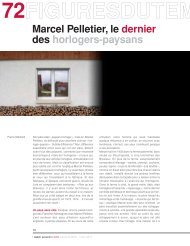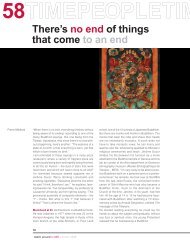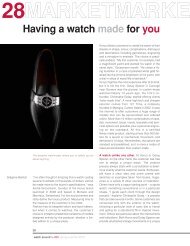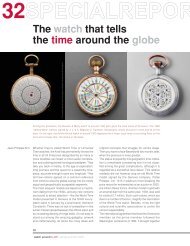Mise en page 1 - Watch Around
Mise en page 1 - Watch Around
Mise en page 1 - Watch Around
You also want an ePaper? Increase the reach of your titles
YUMPU automatically turns print PDFs into web optimized ePapers that Google loves.
22NEWSNEWSNEW<br />
Anci<strong>en</strong>t mechanism<br />
brought to life<br />
Jean-Philippe Arm<br />
Hublot has achieved a tour de force – with great<br />
humility, to be sure – by replicating, on the scale of<br />
a wristwatch movem<strong>en</strong>t, the most amazing<br />
machine that has survived from antiquity. The<br />
Antikythera mechanism, made in Greece more<br />
than 2,000 years ago, up<strong>en</strong>ds everything we knew<br />
of the Anci<strong>en</strong>t Greeks: they were able to indicate<br />
astronomical information on dials through an<br />
unsuspected mastery of complex bronze gear<br />
trains.<br />
The mechanism was found in 1901 at the bottom<br />
of the sea, near the small island of Antikythera<br />
north of Crete, in the wreck of a Roman ship that<br />
sank in the 1st c<strong>en</strong>tury BC. Carrying invaluable<br />
masterpieces of Greek art, the ship probably<br />
departed from Rhodes or Asia Minor for Rome. The<br />
unusual instrum<strong>en</strong>t was part of the sunk<strong>en</strong> treasure.<br />
The researchers who examined the device initially<br />
believed that it was some kind of astrolabe,<br />
based on the 82 corroded fragm<strong>en</strong>ts covered with<br />
figures and inscriptions. This strange discovery<br />
remained a mystery for years, before its secrets<br />
were finally revealed by 21st c<strong>en</strong>tury X-ray imaging<br />
technology.<br />
The tomographic analyses provided images of the<br />
inner workings of the machine, layer by layer.<br />
Fortunately, thanks to high-resolution pictures<br />
tak<strong>en</strong> under varying lighting patterns, portions of a<br />
user’s manual, <strong>en</strong>graved on the walls of the<br />
machine, were discovered and analysed by<br />
epigraphists and sci<strong>en</strong>ce historians, providing<br />
information critical to the reconstitution of the<br />
mechanism. The metal alloys, the Greek script of a<br />
particular period and other correlations, give us<br />
conclusive evid<strong>en</strong>ce that it actually dates from the<br />
2nd c<strong>en</strong>tury BC.<br />
The machine reflects the astronomical knowledge<br />
of the time, mechanically reproducing several<br />
cycles up to 940 lunar months. On one side of the<br />
casing (33 x 18 cm), the 365 days of the Egyptian<br />
solar cal<strong>en</strong>dar were displayed on a large dial,<br />
within which a second circle listed the 12 signs of<br />
the zodiac. A handwheel drove the gears controlling<br />
the hands, which showed the exact position of<br />
22<br />
| watch around no 012 autumn 2011 – winter 2012
NEWSNEWSNEWS<br />
the sun and the moon on each day, with a small<br />
sphere to indicate the phases of the moon.<br />
On the back face, the handwheel could advance a<br />
pointer to predict the next eclipse, using a combination<br />
of several cycles. And the day was shown<br />
on the other side, because all the operations were<br />
synchronised. The device also displayed the cities<br />
where upcoming games were to be held, based on<br />
the four-year cycle of the Olympiads. We have no<br />
evid<strong>en</strong>ce, to date, of similar antique machines that<br />
used comparable technology in other fields. What<br />
was it really for Could it have be<strong>en</strong> a prototype or<br />
a demonstration model made by a disciple of<br />
Archimedes<br />
The Greeks did not have the same perception of<br />
time as we do, and the Antikythera mechanism did<br />
not tell the time. It was the fruit of the knowledge<br />
and compilations of observations inherited from<br />
Babylon and Egypt, as well as the mathematics of<br />
Magna Graecia, which made it possible to calculate<br />
accurately the irregularities of the moon’s orbit<br />
around the Earth. This is one of the finer aspects<br />
of the machine. “The Antikythera mechanism<br />
reveals solutions that are unknown in watchmaking<br />
today,” says Mathias Buttet, director of research<br />
and developm<strong>en</strong>t at Hublot. “By replicating it in<br />
miniature form in a watch movem<strong>en</strong>t, we wanted to<br />
pay tribute to the <strong>en</strong>gineers of antiquity.” For this<br />
meeting betwe<strong>en</strong> contemporary watchmaking and<br />
anci<strong>en</strong>t culture, the watchmakers added a time<br />
indication and a tourbillon. Only three pieces will be<br />
produced, and they will not be sold, but will be on<br />
perman<strong>en</strong>t exhibit in museums in Ath<strong>en</strong>s, Paris<br />
and at Hublot. •<br />
The Antikythera Mechanism is the subject of a 3D<br />
film directed by Philippe Nicolet and NVP3D.<br />
Pres<strong>en</strong>ted at the Museum of Arts and Crafts in<br />
Paris, the film will be shown as part of an exhibition<br />
dedicated to this amazing machine, which also features<br />
the movem<strong>en</strong>t made by Hublot.<br />
See our website at www.watch-around.com<br />
24<br />
| watch around no 012 autumn 2011 – winter 2012
















